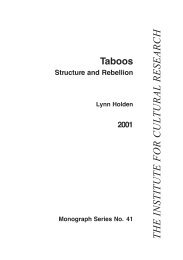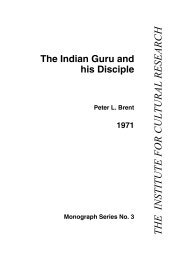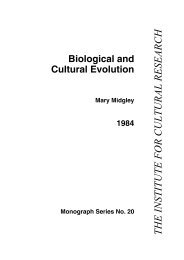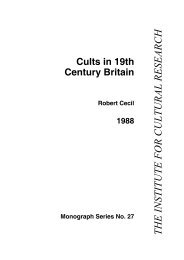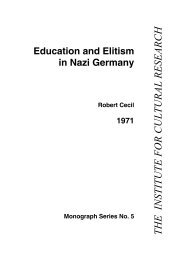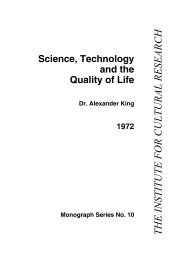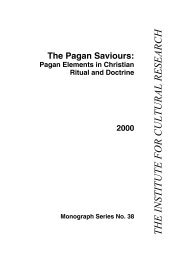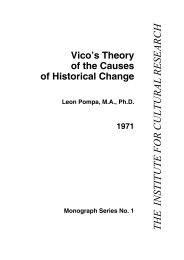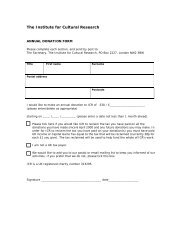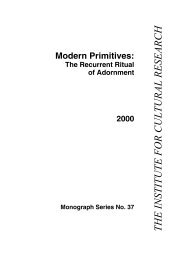Cultural Identity: Solution or Problem - The Institute For Cultural ...
Cultural Identity: Solution or Problem - The Institute For Cultural ...
Cultural Identity: Solution or Problem - The Institute For Cultural ...
Create successful ePaper yourself
Turn your PDF publications into a flip-book with our unique Google optimized e-Paper software.
social evolutionists. It was an imp<strong>or</strong>tant part of the cultural<br />
relativism of anthropology (which had some roots in the ideas of<br />
Enlightenment thinkers such as Rousseau, Voltaire <strong>or</strong> Swift that<br />
European society was not necessarily the best possible society). A<br />
pluralist notion of cultures was a m<strong>or</strong>e democratic and egalitarian<br />
approach: there are many different cultures and they cannot<br />
necessarily be arranged in an easy hierarchy of ‘civilisation’.<br />
However, there were also problems involved in thinking about<br />
culture in this way. 11 It was tempting, and useful in some ways, to<br />
focus on ‘bounded’ communities as objects of detailed attention<br />
which could be seen as functioning systems, but in fact communities<br />
and much less whole cultures are not bounded at all; cultures are not<br />
divided up into neat bits, sitting like sea-shells on the sand ready f<strong>or</strong><br />
the analyst’s attention. From the 1960s, anthropologists began to<br />
highlight the interconnectedness of ‘cultures’ and the hist<strong>or</strong>y of<br />
changing ‘primitive cultures’. To give a concrete example, the<br />
Mundurucu Indians of the Amazon region had a particular type of<br />
kinship arrangement in which villages were built round groups of<br />
related men. Women left their natal communities and married into<br />
their husbands’ villages. With Spanish contact in the late eighteenth<br />
century and especially with the ninetenth-century rubber boom in<br />
the region, Mundurucu men were frequently hired by colonists as<br />
fighters, while the women took on the role of food providers f<strong>or</strong> the<br />
whites. This gradually changed villages into groups of related<br />
women, who lived together to better cultivate manioc, with men as<br />
m<strong>or</strong>e mobile individuals who married into these communities.<br />
Hence hist<strong>or</strong>y and interconnectedness mattered in the definition of<br />
what Mundurucu culture was in the twentieth century when<br />
anthropologists went to study them; this culture could not be seen as<br />
a bounded unit, on its own and outside hist<strong>or</strong>y, because it very<br />
structure responded to the presence of other cultures.<br />
It also became clear that ‘cultures’ are relational, that is, they are<br />
defined by their difference from others, at various levels. <strong>The</strong> ‘Welsh’<br />
as a culture are defined in part by their difference from the ‘English’;<br />
both these take their shape in part from their difference in relation to<br />
others, such as the ‘French’; all three can be grouped as ‘European’<br />
in contrast to ‘Africans’, and so on. Hence ‘culture’ is a relative term.<br />
In addition, what counts as a significant ‘difference’ depends on who<br />
is doing the classifying. What is a min<strong>or</strong> cultural difference to one<br />
11



